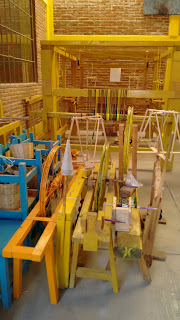Life in San Cristobal
Post by Almu, Tumaini Communication
San Cristóbal de las Casas is the city that we liked the most on our trip through Mexico. We have spent ten days and we leave with the feeling that we still have a lot to discover.
San Cristóbal de las Casas is the city that we liked the most on our trip through Mexico. We have spent ten days and we leave with the feeling that we still have a lot to discover.
This city has a great colonial beauty, a cultural life that does not stop, political and social demands and numerous projects that try to give a better life to the community.
 |
| Women of the Tzotzil community |
In the state of Chiapas, most of the population is indigenous. We were able to visit a Tzotzil community, where the women speak this language, they do not understand Spanish. The community is only half an hour drive from San Cristóbal. It is one of the communities with which the textile cooperative with which we are going to collaborate works.
Indigenous people have always been discriminated against and thanks to the Zapatista movement they managed to have more rights, although much remains to be done. To this day at least they have the right to claim these rights. Before, for example, they were not allowed to walk on the sidewalks.
 |
| One of the shops in the Fair Trade center |
In this city, cooperatives have been created that work with indigenous communities and that sell their artisan products through Fair Trade. There are numerous stores that you can see in the center and that have this seal.
There are also cultural centers where you can watch documentaries and movies where you can learn more about how these communities live. One of them is Kinoki, which we have already told you about and is a must-see in San Cristóbal.
Another important thing is to talk to your people. They explain to you how they live, what their day to day is like. At a market stall, an indigenous artisan woman with her son in her arms and her two other daughters playing with their feet, told us that the stall only gave them enough to eat.
The driver of an excursion that we did, explained to us that a few years ago an indigenous person tried to sell his products in the market and in the end he had to do it at a lower price because they threatened to call the authorities, they had no right.
Now the situation is better, although they have also told us how a large multinational is leaving several communities without water supply and at the moment nothing can be done.
We have met young indigenous people who, leaving their communities, have been able to study in the city thanks to the support of cooperatives where their mothers are and also schools like CIDECI.
We leave with the feeling that we still have a lot to know and learn. But we are sure that we will return soon.




